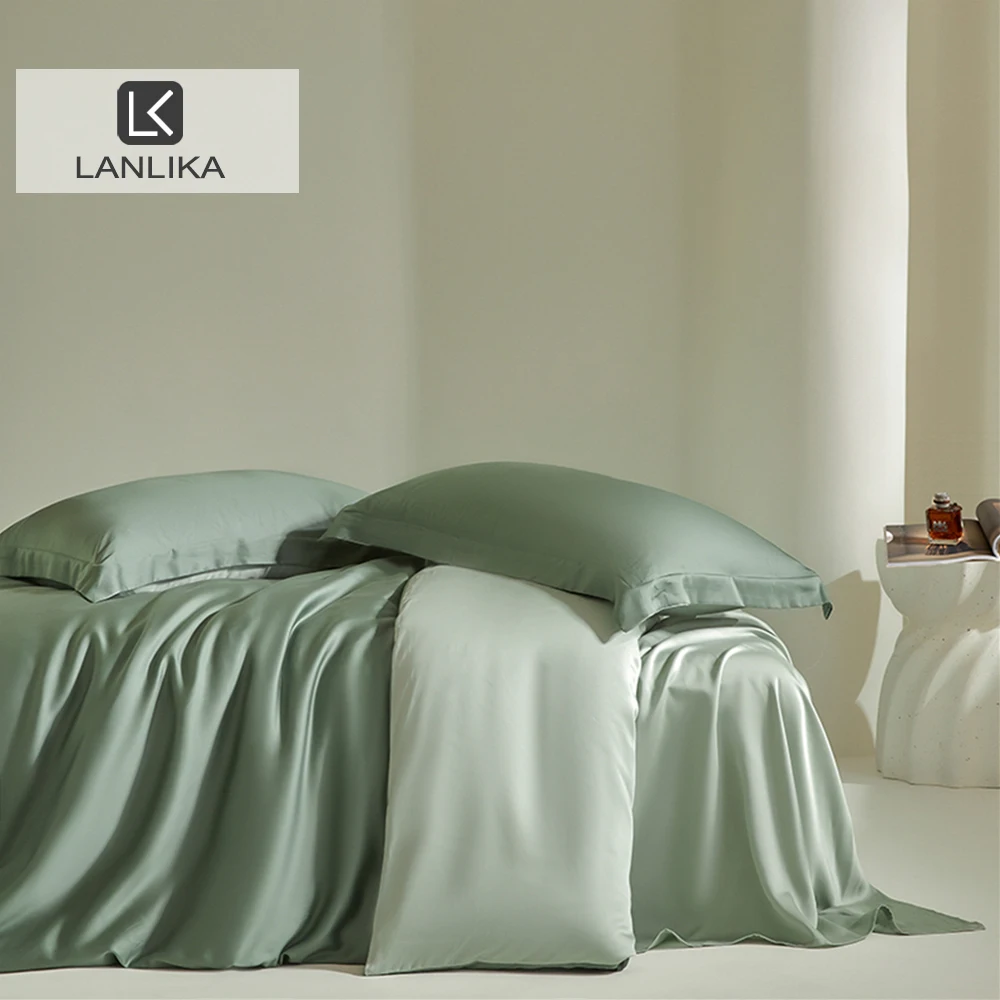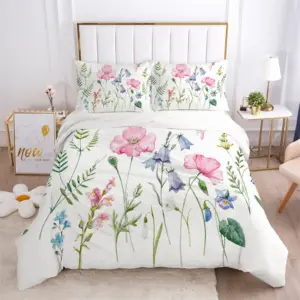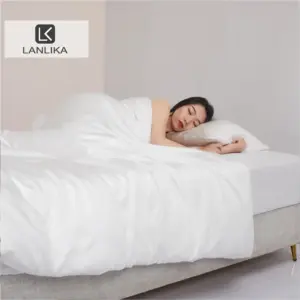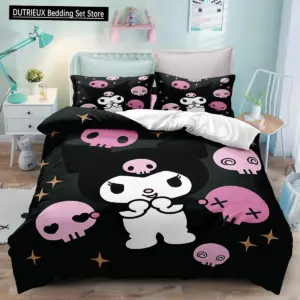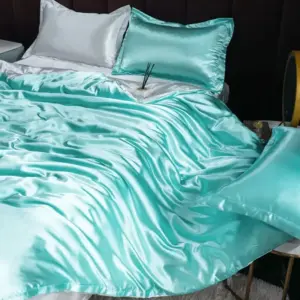Introduction
Choosing the right size silk bedding isn’t just about fitting your mattress—it’s about creating the perfect sleep sanctuary that balances comfort, aesthetics, and functionality. When it comes to luxury silk bedding, size considerations take on even greater importance due to silk’s unique draping qualities and the premium nature of the material. Every inch matters in how your bedding looks, feels, and performs.
Understanding the fundamental queen vs king silk bedding differences is essential for making an informed decision that will affect your sleep experience for years to come. With silk being an investment in your sleep quality, you want to ensure you’re selecting dimensions that perfectly complement your space and sleeping habits.
Unlike conventional cotton bedding, silk has distinctive properties that make sizing particularly important. The material’s natural weight and drape create a distinctive visual appeal that changes with size, while the amount of premium silk used directly impacts both cost and the luxurious feel against your skin.
In this comprehensive guide, we’ll explore the exact dimensions of both king and queen silk sheet comparison, room compatibility considerations, silk-specific factors like momme weight, and the price differences you can expect when choosing between these popular sizes. Let’s begin by understanding the foundation of your silk bedding: the mattress dimensions.
Queen vs. King Mattresses: The Foundation for Your Silk Bedding
To understand silk bedding sizing, we must first examine the mattresses these luxurious pieces are designed to cover:
Queen Mattress Dimensions:
* 60 inches wide by 80 inches long (152 cm × 203 cm)
* The most popular mattress size for couples
* Fits comfortably in bedrooms of moderate size
King Mattress Dimensions:
* 76 inches wide by 80 inches long (193 cm × 203 cm)
* 16 inches (41 cm) wider than a Queen while maintaining the same length
* Offers significantly more surface area for couples who value personal space
This fundamental width difference of 16 inches dictates all aspects of your silk bedding components, from sheets to duvet covers. It’s important to note that while standard Queen and King sizes are most common, variations like California King (72 inches wide by 84 inches long) offer different proportions for taller individuals.
When choosing between king and queen silk sets, the mattress dimensions serve as your starting point, with all other bedding elements designed to accommodate these specific measurements. The right fit ensures your silk bedding drapes beautifully while staying securely in place throughout the night.
Complete Dimensional Comparison: Queen vs. King Silk Bedding Components
To help you understand exactly how Queen and King silk bedding differs, here’s a comprehensive comparison of each component’s typical dimensions:
| Bedding Component | Queen Size | King Size |
|---|---|---|
| Fitted Sheet | 60” × 80” × 15” (152 × 203 × 38 cm) | 76” × 80” × 15” (193 × 203 × 38 cm) |
| Flat Sheet | 96” × 102” (244 × 259 cm) | 108” × 102” (274 × 259 cm) |
| Duvet Cover | 88” × 90” (223 × 229 cm) | 104” × 90” (264 × 229 cm) |
| Standard Pillowcase (each) | 20” × 30” (51 × 76 cm) | 20” × 40” (51 × 102 cm) |
| Silk Comforter | 90” × 90” (229 × 229 cm) | 106” × 90” (269 × 229 cm) |
Silk fitted sheets require special attention to pocket depth (the third dimension noted above), particularly if you have a pillowtop mattress or use a mattress topper. Standard pocket depths range from 12-15 inches, but luxury mattresses may require deeper pockets of 17-22 inches to ensure proper fit without slipping.
The flat sheet dimensions are notably generous compared to the mattress size, allowing for proper tucking and the elegant drape that makes silk bedding so visually appealing. King flat sheets offer substantially more width to accommodate the wider mattress and provide similar overhang on each side.
Pillowcase sizes represent another significant difference between these bedding sets. King pillowcases are typically 10 inches longer than standard/Queen ones, accommodating the larger pillows that help fill the width of a King mattress appropriately.
Browsing through our king size silk bedding sets collection, you’ll notice how these dimensions translate into a luxuriously proportioned sleep experience that maximizes the benefits of silk’s natural properties.
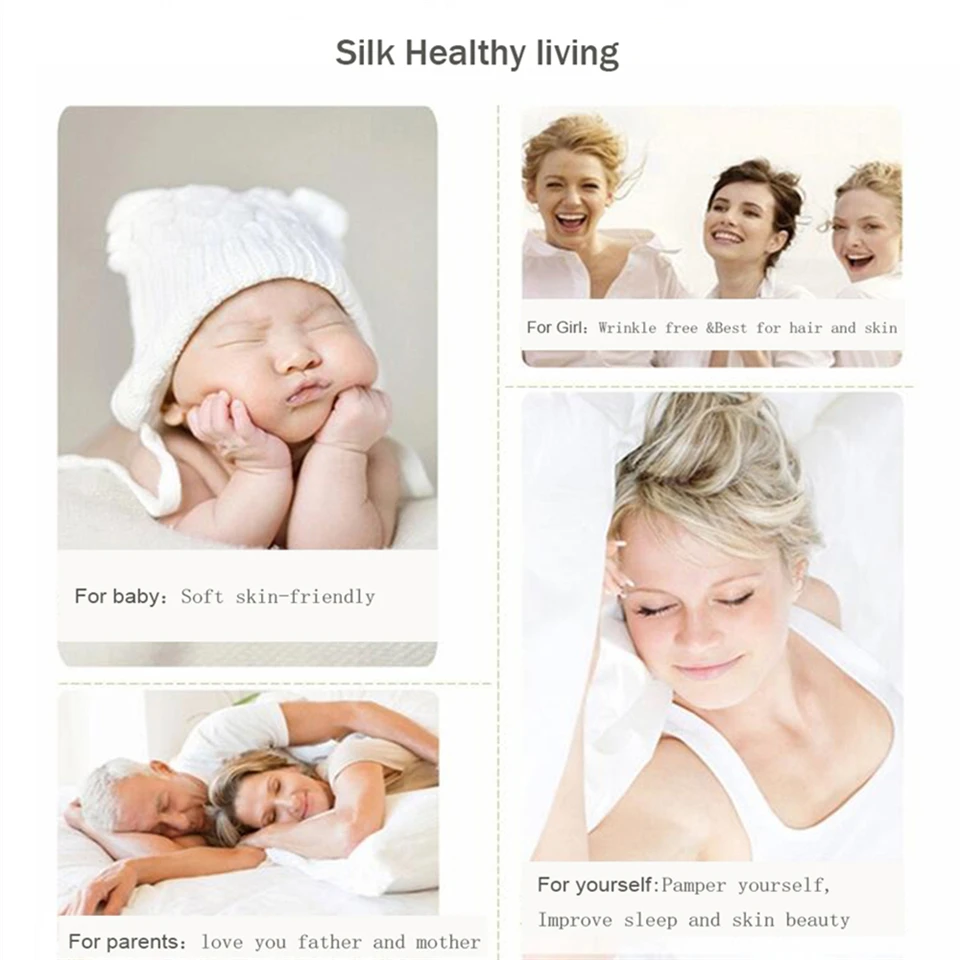
Which Size is Right for You? Room Considerations and Sleeping Preferences
Queen Silk Bedding: Ideal Scenarios
Queen silk bedding offers the perfect balance of luxury and practicality for many sleepers:
- Single sleepers enjoy abundant space while maintaining a cozy feel
- Couples who prefer closeness find the dimensions intimate yet comfortable
- Smaller master bedrooms (minimum 10×10 feet or 3×3 meters) accommodate this size without feeling cramped
- Budget-conscious luxury shoppers appreciate the lower price point without sacrificing silk quality
- Easier maintenance with less fabric to handle during washing and bed-making
Many homeowners with average-sized bedrooms find that Queen silk bedding provides the perfect balance between luxury and functionality. The queen size silk bedding sets offer enough space for most couples while leaving adequate room around the bed for nightstands and easy movement.
King Silk Bedding: Ideal Scenarios
King silk bedding creates a truly luxurious sleep experience with maximum space:
- Couples who value personal space gain equivalent of two twin XL areas
- Families who co-sleep with children or pets have room for everyone
- Larger master bedrooms (minimum 12×12 feet or 3.7×3.7 meters) showcase the bed as a magnificent centerpiece
- Luxury enthusiasts enjoy maximum silk surface area for experiencing the fabric’s benefits
- Restless sleepers benefit from undisturbed movement without affecting partners
King beds make a grand statement in spacious bedrooms while providing unmatched sleeping space. The extra width transforms your sleep experience, offering a level of comfort particularly beneficial for those who move frequently during sleep or share their bed.
The right choice ultimately depends on your specific situation, considering both your bedroom dimensions and personal sleeping preferences. Either size delivers the exceptional benefits of luxury silk bedding while accommodating different spatial and lifestyle needs.
Understanding Silk Quality: Momme Weight and Its Importance
While size is a critical factor in selecting silk bedding, understanding silk quality is equally important for making an informed decision. Unlike cotton, which uses thread count as its primary quality metric, silk quality is measured in “momme” (pronounced “mummy”), which indicates the weight of silk per standard measuring unit.
What is Momme Weight?
Momme weight measures silk’s density—specifically, the weight in pounds of a piece of silk measuring 45 inches by 100 yards. Higher momme numbers indicate heavier, more durable, and typically more luxurious silk.
Recommended Momme Ranges:
- Light (16-19 momme):
- More affordable entry point into silk bedding
- Lighter, more breathable feel ideal for summer
- Semi-transparent appearance
Shorter lifespan than heavier options
Medium (19-22 momme):
- Optimal balance between quality and value
- Suitable for year-round use
- Good opacity and elegant drape
Durable with proper care
Heavy (22-30 momme):
- Premium luxury feel with maximum durability
- Substantial weight creates magnificent draping
- Excellent opacity and luster
- Longest lifespan, often lasting many years
The way silk drapes across your bed depends significantly on its momme weight, with heavier silks creating more dramatic folds and a more substantial feel against your skin. When choosing between Queen and King sizes, remember that the visual impact of silk’s natural drape becomes more pronounced with the larger dimensions of King bedding.
For those new to luxury silk, our ultimate guide to luxury silk bedding offers comprehensive insights into selecting the perfect combination of size and quality for your needs.
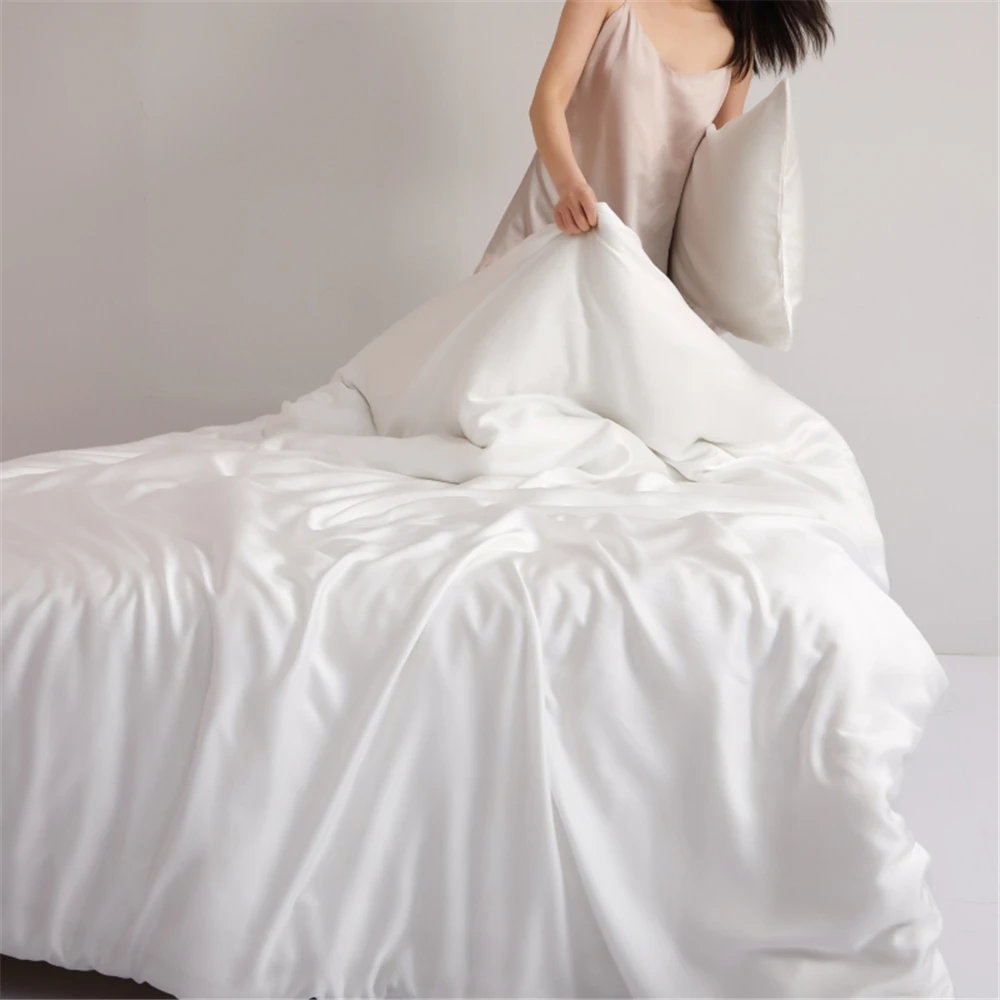
How Size Affects Silk Bedding Costs: Queen vs. King Price Comparison
The price difference between Queen and King silk bedding is substantial and directly relates to the increased material usage and manufacturing complexity:
- Sheet sets: King sets typically cost $50-100 more than Queen equivalents
- Duvet covers: Expect a $70-120 premium for King over Queen sizes
- Pillowcases: King pairs generally cost $15-30 more than standard/Queen pairs
These price differences become more pronounced as the momme weight increases. For example, a 22-momme King sheet set might cost $150 more than its Queen counterpart, while the difference for a 19-momme set might be closer to $80.
Consider this cost difference as an investment calculation. If you plan to keep your bedding for many years (quality silk can last 5-10 years with proper care), the annual cost difference becomes quite reasonable. For couples who value extra sleeping space, the additional investment in King-sized silk bedding often delivers significant value in comfort and sleep quality.
Budget-conscious shoppers might consider whether prioritizing size or momme weight better suits their needs. Some find that a higher-quality Queen set provides a better overall experience than a lower-quality King set at a similar price point.
Understanding whether silk bedding is worth the investment helps put these price differences into perspective relative to the longevity and benefits you’ll receive.
Essential Tips for Buying the Right Size Silk Bedding
To ensure your silk bedding investment provides maximum satisfaction, follow these essential tips:
Measure your mattress thoroughly—not just length and width, but also height/depth from the bottom to the top surface. Modern mattresses, particularly pillowtops, can be substantially taller than standard dimensions.
Understand pocket depth requirements for fitted sheets. If your mattress is 14 inches tall or uses a mattress topper, look for deep-pocket fitted sheets (15-18 inches) to prevent corners from slipping off.
Determine your overhang preference for flat sheets and duvet covers. Some prefer a generous drape that nearly touches the floor, while others prefer a more tailored look with less overhang.
Consider pillowcase compatibility with your existing pillows. King pillowcases accommodate king-sized pillows (20×36 inches), while standard/queen pillowcases fit standard pillows (20×26 inches).
Check for pre-shrinkage allowances in the measurements. Quality silk bedding manufacturers account for minimal shrinkage in their sizing specifications.
Factor in silk’s thermal regulation properties when deciding between sizes. Larger silk sheets provide more surface area of this naturally temperature-regulating fabric against your skin.
Consider ease of maintenance in your decision. Larger King silk items require more careful handling during washing and may be more challenging to air-dry properly.
Our mulberry silk bedding sets come in various sizes with detailed specifications to help you make these important assessments.
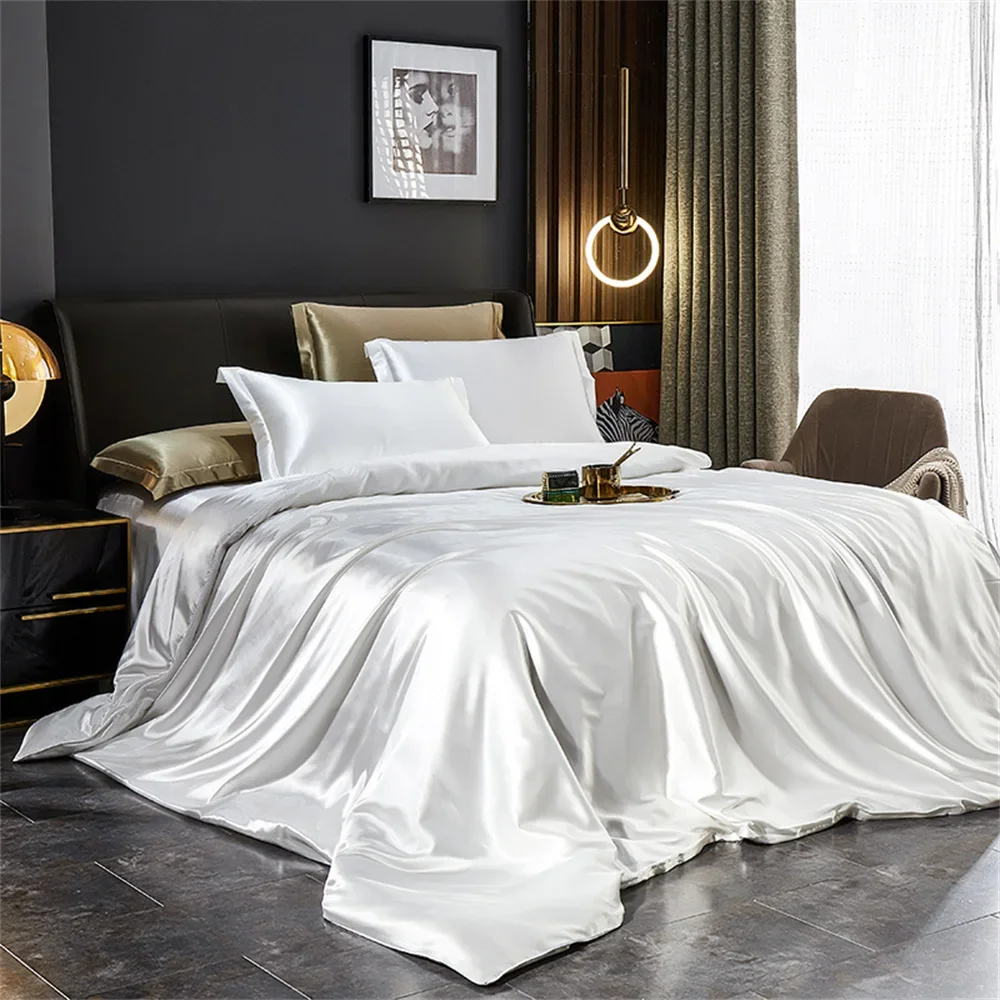
Finding the Perfect Balance: Silk Quality vs. Size Considerations
When working within budget constraints, you may face a choice between a higher-quality Queen set or a lower-quality King set. This decision requires balancing several factors:
If sleeping space is your primary concern, a King set may be worth the compromise on momme weight. However, if the sensory experience of premium silk matters most, investing in a higher momme Queen set might provide greater satisfaction.
Seasonal needs also play a role in this decision. In warmer months, silk bedding performs well in summer regardless of size, but the larger surface area of King bedding provides more cooling silk contact. During winter, the insulating properties of higher momme silk might take priority over size.
Consider also how each family member’s preferences affect this balance. If one person sleeps hot while another feels cold, a higher-quality silk with excellent temperature regulation might be more valuable than extra space.
The best long-term strategy often involves investing in quality first, then size. Many customers begin with a high-quality Queen set and upgrade to King when budget allows, rather than compromising on the silk quality that will affect daily comfort and longevity.
100% Silk Sheets, Green Silk Sheets, King Size Silk Bedding Set, Mulberry Silk Bedding Sets, Queen Size Silk Bedding Set
Price range: $1,246.21 through $1,615.22 Select options This product has multiple variants. The options may be chosen on the product pageFull Silk Bedding Set, King Size Silk Bedding Set
Price range: $120.99 through $190.49 Select options This product has multiple variants. The options may be chosen on the product pageGrey Silk Sheets, Silk Sheet and Pillowcase Set
Price range: $88.20 through $146.64 Select options This product has multiple variants. The options may be chosen on the product page100% Silk Sheets, King Size Silk Bedding Set, Mulberry Silk Bedding Sets, Queen Size Silk Bedding Set, White Silk Sheets
Price range: $1,000.79 through $1,351.42 Select options This product has multiple variants. The options may be chosen on the product pageKing Size Silk Bedding Set, Twin Silk Bedding Set
Price range: $120.99 through $190.49 Select options This product has multiple variants. The options may be chosen on the product pageLuxury Silk Bedding Sets, Mulberry Silk Bedding Sets, Silk Sheet and Pillowcase Set
Price range: $61.33 through $159.87 Select options This product has multiple variants. The options may be chosen on the product page
Is Silk Bedding Worth the Extra Cost in King Size?
Many customers wonder whether the premium price for King silk bedding delivers proportional value. The answer depends on several factors:
The extra width of King silk bedding provides 16 more inches of luxury fabric contact, which enhances the skin and hair benefits that silk naturally provides. For couples, this transforms the sleeping experience from adequate to exceptional by eliminating the need to compete for space.
From a visual perspective, King silk bedding creates a more dramatic statement in your bedroom. The additional surface area showcases silk’s natural luster and drape more effectively, elevating the room’s aesthetic appeal.
While King silk bedding costs more initially, the per-year cost difference becomes minimal when considering its longevity. Quality silk typically lasts 5-10 years with proper care, making the annual price difference between Queen and King sizes relatively small.
For those who view their bedroom as a personal retreat, the psychological value of spacious King silk bedding can far outweigh the additional cost. The feeling of luxurious abundance contributes significantly to creating a true sleep sanctuary.
How to Properly Care for Queen and King Silk Bedding
Proper care extends the life of your silk bedding investment, regardless of size. However, larger King pieces do present some unique considerations:
Washing techniques: Hand-washing remains ideal for all silk, but King-sized pieces require a larger basin or tub. If machine washing, use a front-loader or large-capacity top-loader without an agitator to accommodate the extra fabric without crowding.
Drying challenges: King silk items need more space to air dry properly. Consider hanging fitted sheets from multiple points to prevent pooling of water in the center, which can cause uneven drying.
Storage requirements: Larger silk pieces need more shelf space and should never be tightly folded for long periods. Use acid-free tissue paper between folds to prevent permanent creasing of King-sized items.
Handling during changes: Changing King silk bedding often requires two people for smooth, stress-free installation that avoids pulling on the delicate fabric, while Queen bedding can typically be managed by one person.
Ironing considerations: If you prefer pressed silk bedding, King sizes require more time and a larger ironing surface. Always use the silk setting and iron on the reverse side.
Regardless of size, all silk bedding benefits from gentle washing with pH-neutral detergents, protection from direct sunlight, and storage away from wood surfaces that can transfer oils to the fabric.
Can You Mix Queen and King Silk Bedding Components?
While consistency is generally preferred, mixing components between Queen and King silk bedding can work in certain circumstances:
Using King pillows with Queen bedding creates a luxurious look with pillows that extend beyond the width of the bed, offering extra support for reading or watching TV. However, standard Queen pillowcases won’t fit King pillows properly.
King flat sheets can sometimes work on Queen beds if you prefer extra drape and overhang, though you’ll need to tuck in more fabric at the foot. The reverse—using Queen flat sheets on King beds—isn’t recommended as the sheets won’t provide adequate coverage.
Queen duvet inserts in King duvet covers create a softer, less filled look that some prefer aesthetically, though the cover may appear slightly baggy. This combination can work well in warmer months when less fullness is desired.
For visual coherence, maintaining consistency in silk quality and color is more important than perfect size matching when mixing components. The subtle sheen and texture of silk will appear more harmonious when the fabric quality matches, even if sizes differ.

